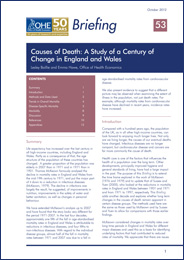Unlocking the Value of Combination Therapies

This Briefing extends to 2007 Thomas McKeown’s well-known analysis of changes in life expectancy in England during 1901-1971. It finds that mortality continued to decline after 1971, but that the causes of death have changed.
McKeown attributed the 30-year increase in life expectancy that…
This Briefing extends to 2007 Thomas McKeown’s well-known analysis of changes in life expectancy in England during 1901-1971. It finds that mortality continued to decline after 1971, but that the causes of death have changed.
McKeown attributed the 30-year increase in life expectancy that he identified to reductions in infectious diseases. Baillie and Hawe find that almost 20% of the decline in mortality during 1971-2007 is the result of lower age-standardised mortality rates for just one cause of death—cardiovascular disease, despite an increase in incidence rates for that disease.
The Briefing highlights some diseases for which age-standardised mortality rates in recent years have risen. For example, between 1997 and 2007, mortality rates increased for diseases of the digestive system, including fibrosis and cirrhosis of the liver. According to the authors, “This may indicate that whereas, in the past, changes in sanitation and other public factors outweighed effects from personal behaviours, in the current day negative personal behaviours can increase the risk for both morbidity and mortality from certain diseases (e.g. obesity and diabetes)”.
At the same time that life expectancy has increased, so has the number of individuals living with chronic disease. Not surprisingly, the percentage of the population reporting chronic ill health has increased the most for those aged 65 and over—from 53% in 1972 to 63% in 2007.
Causes of Death: A Study of a Century of Change in England and Wales
